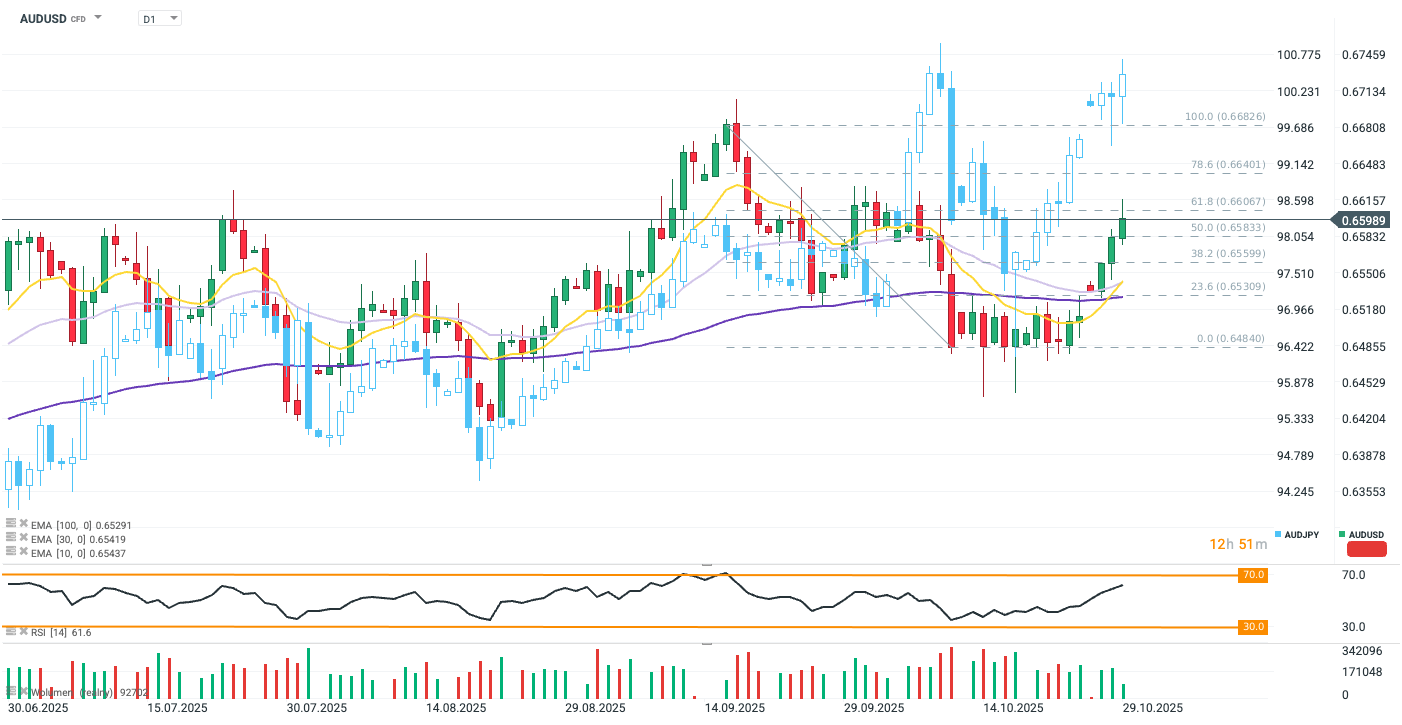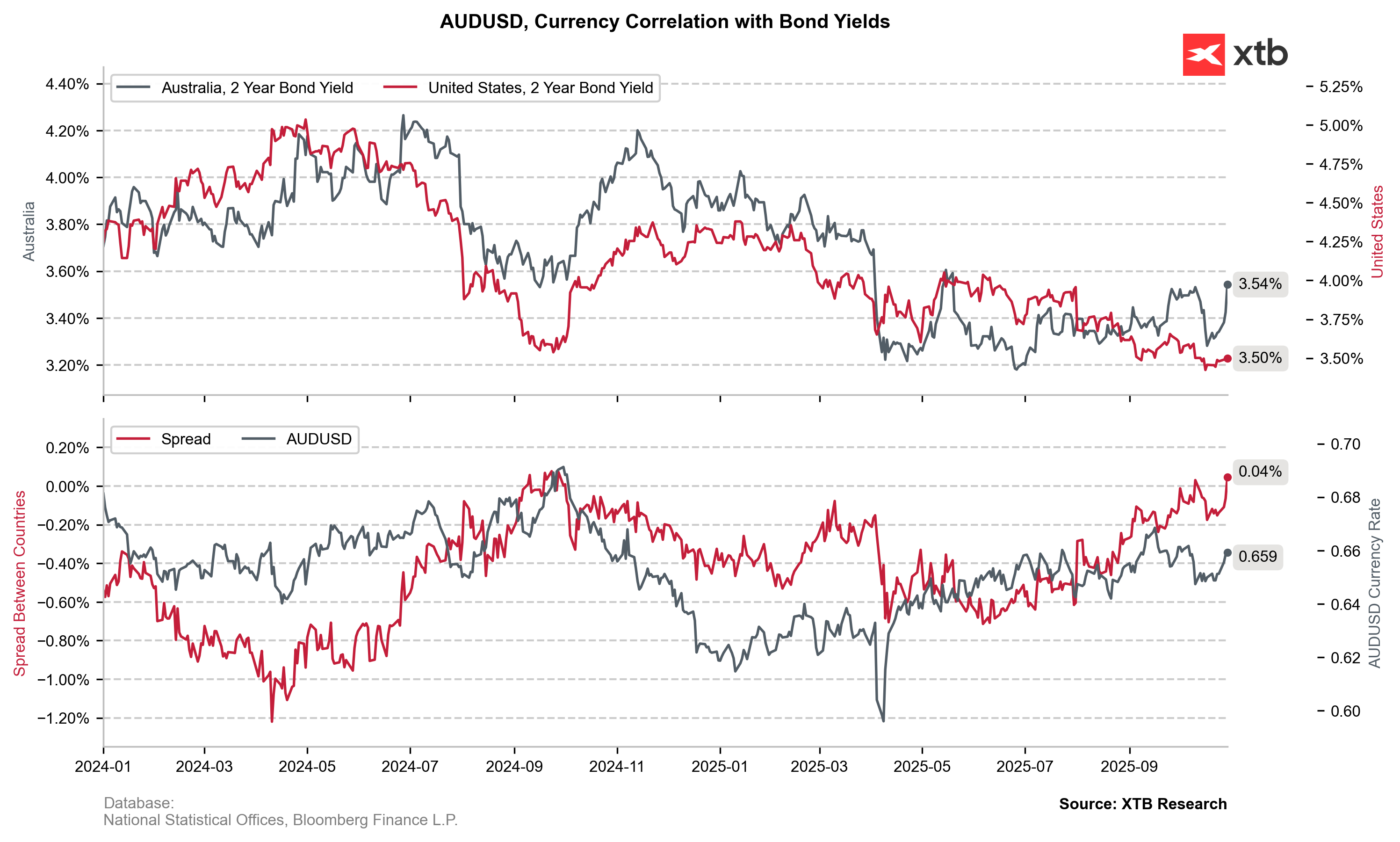- The Australian dollar is the strongest G10 currency today, gaining 0.25% against the U.S. dollar and 0.3% against the euro.
- CPI inflation surged to a more-than-one-year high of 3.2%, reducing expectations of further interest rate cuts.
- The AUD is further supported by a global rise in risk appetite.
- The Australian dollar is the strongest G10 currency today, gaining 0.25% against the U.S. dollar and 0.3% against the euro.
- CPI inflation surged to a more-than-one-year high of 3.2%, reducing expectations of further interest rate cuts.
- The AUD is further supported by a global rise in risk appetite.
AUDUSD gains 0.25% on the back of Australia’s strongest CPI inflation data in over a year, which reduces the likelihood of further rate cuts. Hawkish expectations toward the Reserve Bank of Australia (RBA), coupled with a broader risk-on sentiment and renewed optimism over a potential U.S.-China trade peace, are making the Australian dollar the best-performing G10 currency this week.

AUDUSD broke above the 50% Fibonacci retracement level of the latest downward wave but encountered resistance near recent highs around 0.66. Strong “risk-on” momentum is also visible on AUDJPY (in blue). Source: xStation5
What’s driving AUDUSD today?
-
Consumer inflation (CPI) rose in Q3 2025 to 3.2% (previous: 2.1%, consensus: 3%) — the highest since Q2 2024. Even more concerning for price stability, monthly data show core inflation accelerating to 3.7% in September. The main price pressures came from housing (+2.5% q/q), recreation and culture (+1.9%), and transport (+1.2%), while electricity prices surged 9%.
-
The higher-than-expected reading ties the RBA’s hands, after the central bank paused easing in September amid worrying monthly data (rates have remained at 3.6% since August). The RBA has emphasized its preference for less volatile quarterly figures, so this clear confirmation of persistent inflation significantly reduces the likelihood of further rate cuts. Moreover, the trimmed mean CPI — which excludes extreme price movements — exceeded the RBA’s forecast for the first time since 2022.
-
Still, the RBA faces a policy dilemma, balancing resurgent inflation against a slowing labor market. Unemployment rose to 4.5% last month, the highest in nearly four years, though Governor Michele Bullock maintained a hawkish tone, noting labor data volatility and that “unemployment hasn’t risen much above forecasts.”
-
As a result, the AUD strengthened broadly, extending this week’s bullish pivot against the U.S. dollar. The currency is also supported by global risk appetite, fueled by strong Wall Street earnings, progress in Trump’s trade talks with China and rising Australian bond yields.

Australian 2-year yields have climbed roughly 20 bps since the start of the week to their highest level since May 2025, with AUDUSD closely tracking the yield spread after a brief period of stagnation. Source: XTB Research, Bloomberg data.
Daily summary: Wall Street tries to rebound 📈Amazon and Microsoft under pressure of Rotschild & Co Redburn
Cocoa tries to stabilize after autumn sell-off 📌
Fed's Barkin remarks on US economy 🗽EURUSD drops to 1.157
📌US500 loses 1%
The content of this report has been created by XTB S.A., with its registered office in Warsaw, at Prosta 67, 00-838 Warsaw, Poland, (KRS number 0000217580) and supervised by Polish Supervision Authority ( No. DDM-M-4021-57-1/2005). This material is a marketing communication within the meaning of Art. 24 (3) of Directive 2014/65/EU of the European Parliament and of the Council of 15 May 2014 on markets in financial instruments and amending Directive 2002/92/EC and Directive 2011/61/EU (MiFID II). Marketing communication is not an investment recommendation or information recommending or suggesting an investment strategy within the meaning of Regulation (EU) No 596/2014 of the European Parliament and of the Council of 16 April 2014 on market abuse (market abuse regulation) and repealing Directive 2003/6/EC of the European Parliament and of the Council and Commission Directives 2003/124/EC, 2003/125/EC and 2004/72/EC and Commission Delegated Regulation (EU) 2016/958 of 9 March 2016 supplementing Regulation (EU) No 596/2014 of the European Parliament and of the Council with regard to regulatory technical standards for the technical arrangements for objective presentation of investment recommendations or other information recommending or suggesting an investment strategy and for disclosure of particular interests or indications of conflicts of interest or any other advice, including in the area of investment advisory, within the meaning of the Trading in Financial Instruments Act of 29 July 2005 (i.e. Journal of Laws 2019, item 875, as amended). The marketing communication is prepared with the highest diligence, objectivity, presents the facts known to the author on the date of preparation and is devoid of any evaluation elements. The marketing communication is prepared without considering the client’s needs, his individual financial situation and does not present any investment strategy in any way. The marketing communication does not constitute an offer of sale, offering, subscription, invitation to purchase, advertisement or promotion of any financial instruments. XTB S.A. is not liable for any client’s actions or omissions, in particular for the acquisition or disposal of financial instruments, undertaken on the basis of the information contained in this marketing communication. In the event that the marketing communication contains any information about any results regarding the financial instruments indicated therein, these do not constitute any guarantee or forecast regarding the future results.


